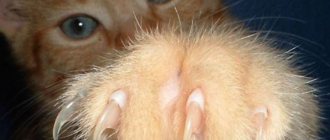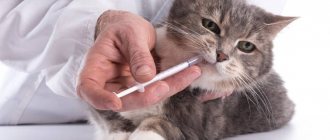Pomeranians are small, very beautiful and fluffy dogs that may appear somewhat larger due to their long and thick coat, which visually gives them additional volume.
It is very important for owners of such pets to know how much their Spitz weighs.
The size and weight of a dog is of considerable importance not only for an exhibition career, but also for the health of Pomeranians.
And, of course, puppy owners need to especially carefully monitor how their pet grows and develops.
Puppy weight and sizes from 1 to 12 months
| Puppy age | Weight (depending on size variety) | Height at withers (average, for standard size dogs) | ||
| Dwarf | Mini | Standard | ||
| At birth | 70-95 grams | 105-125 grams | 130-140 grams | — |
| 1 month | 210-275 grams | 325-370 grams | 460-490 grams | 7-12 cm |
| 2 months | 320-460 grams | 550-620 grams | 680-770 grams | up to 14 cm |
| 3 months | 460-690 grams | 800-920 grams | 1.0-1.15 kg | up to 16 cm |
| 4 months | 600-880 grams | 1.0-1.175 kg | 1.3-1.45 kg | up to 17 cm |
| 5 months | 700-1030 grams | 1.2-1.35 kg | 1.55-1.7 kg | up to 18 cm |
| 6 months | 770-1150 grams | 1.3-1.5 kg | 1.7-1.9 kg | 18-20 |
| 1 year | 1.0-1.4 kg | 1.7-1.9 kg | 2.1-2.3 kg | 18-22 |
Because all puppies grow differently, babies of the same age up to 6 months old can have very different heights at the withers.
Puppy weight and height
At the time of birth, puppies weigh approximately 90-120 g. During the first 9 months of life, the animal is characterized by rapid growth rates. Owners of Pomeranians, who are not familiar with this developmental feature of their dogs, are often perplexed by how quickly weight gain occurs.
To avoid misunderstandings, it is enough to use a special table that shows in detail changes in the body weight of puppies. The top line contains data on the weight of newborns, for each of which their own growth rates are calculated
Pomeranian weight chart
There are 3 stages of development:
- From birth to 9 months - rapid growth with weight gain.
- From 9 to 12 months - weak weight gain (about 0.5 kg).
- From 12 to 15 months - stable weight with slight stretching in height to the final size.
You can calculate the approximate size of an adult dog using a simple formula: height at 2 months*3.
How to measure height correctly?
Having placed a puppy or an adult Pomeranian on the table, you need to attract its attention with a toy or treat. This is done so that the dog gets into a show stance.
After this, take a measuring tape and apply it to the animal’s withers, while its other edge remains hanging freely.
The size of the dog is determined by stretching a measuring tape to the tabletop on which the pet is standing . The distance from the Spitz's scruff to the surface on which the dog stands is its height at the withers.
There is another way to measure the height of an animal, but for this you will need to make a special device.
Take a long and fairly strong ruler with divisions all the way to the bottom, onto which a limiter is placed that moves freely along the length of the measuring device.
The height of the Spitz is measured by placing a ruler on a flat surface next to the dog, and the limiter is moved to the level of the withers..
To what age do they grow?
Pomeranians belonging to different strains may grow differently . Representatives of some already at 4 months almost reach the height and weight of adult animals, while others gain the required size only by 9 months.
On average, Pomeranians are expected to reach full height up to 6 months, but then continue to gain weight for several months afterwards.
It should also be taken into account that the development of bitches may stop with the onset of the first emptying. Some Pomeranian girls, after the end of their first heat, no longer gain a centimeter in height.
The final physical development of a pet of this breed ends at 2-3 years: by this age, the Spitz not only fully grows in height, but also gains the required weight.
Coat type and color
The Dwarf Spitz has become so popular due to its coat. The Pomeranian Dwarf Spitz breed has a double coat: guard and down. The wool is elastic and very dense. On the body of the animal it is usually longer.
An adult dog has a well-developed collar. There may also be “pants” and “feathering”, which is observed on the back of the front legs. All Pomeranians go through a period when their coat looks unpresentable. This is usually typical during adolescence. For an adult animal, this type is considered a marriage. This characteristic of the breed is not known to many dog breeders.
Mini Spitz have fewer colors than those listed in the FCI standard.
The Pomeranian variety is often associated with the color red. However, they are also characterized by the following colors: black, zonal (gray), white, as well as orange, brown and cream. The most common are red and white Spitz, as well as gray dogs.
What affects the development of a puppy?
There are several factors that influence how quickly a Pomeranian puppy grows.:
- Heredity . Puppies from small parents, as a rule, are also born small. If one of the manufacturers was small, and the second almost grew to the upper limit of the standard, then options are possible. Babies from such litters can grow up to be both large and small. Considering that genes can go any way, none of the responsible breeders guarantees that this or that puppy will grow up to be small or, conversely, large. In addition, representatives of different lines gain height and weight differently, which also affects the growth rate of puppies.
- Quality of litter rearing . Conscientious breeders feed their babies the best food they can afford. Breeders often deliberately underfeed puppies so that they grow worse and look smaller. Subsequently, poor-quality feeding will inevitably affect the growth and development of the small Spitz, although, probably, over time it will be able to catch up in size with its peers.
- Feeding and maintenance. Depending on whether a growing orange eats natural food or prepared food, it will grow differently. Babies who are fed home-cooked food grow faster and already at 4-6 months reach the height and, sometimes, the weight of adult animals. When feeding dry food, the puppy will grow more slowly. But in the end, it will still reach the same size as when eating “natural” food. It's just that it will happen a little later.
- Vitamins . If you give your pet vitamin and mineral supplements, he will gain height and weight faster. But this does not mean at all that the Spitz will grow larger or heavier because of the vitamins. The exception is special supplements to increase muscle mass, which are contraindicated for Pomeranians in principle.
- Physical activity . Proportionate physical activity helps the puppy to develop properly. Such a Spitz probably won’t grow any larger than its littermates while away the time on the couch. But, unlike them, he will be more athletic and highly forward, which is why he will look taller and more proportional to them.
What to feed a Spitz puppy
From the age of one month, you can start feeding the puppy with raw minced beef, prepared yourself, by cranking the meat 2 times in a meat grinder, giving it to the baby in the form of small balls and little by little. Then you need to gradually introduce dairy products: cottage cheese, yogurt, kefir, etc. – they should be low-fat, without harmful additives. It is good to feed your baby orange with rice or buckwheat porridge with meat.
Infrequently, you can give low-fat boiled sea fish, boiled chicken, turkey or rabbit. You can also add boiled chicken yolk to your meals 2 times a week. Natural products should be fed alternately with dry food, good quality, pre-soaked with water.
To feed the puppy, you need to purchase special dishes and immediately determine a permanent place for this.
, and feed at approximately the same time:
- at 2 months – feed 5 times a day;
- at 3-4 months - feed 4 times a day;
- at 4-6 months - 3 or 4 times a day;
- from 6 months - 3 or 2 feedings a day;
- from 8 months – 2 feedings a day.
What to do if your weight is below normal
A slight lag in weight from the norm (5-10% of body weight) is not an indicator of abnormal development of the puppy. The baby probably has lighter bones, or maybe he is simply not growing quite evenly: first he gains height, and then body weight.
The main criterion in this case should be the well-being and activity of the pet..
If the weight gap exceeds 10% of the recommended norm, then measures need to be taken. You may have to increase the calorie content of your food or change the brand of food.
If the lag in weight is due to improper rearing or the Pomeranian, as a puppy, suffered from something serious, you cannot do without consulting a veterinarian.
In some cases, increasing the duration of walks and the intensity of physical activity will also be useful, especially if the dog previously led a sedentary lifestyle..
In order to know exactly how the pet’s growing up process will proceed, it is recommended to ask the breeder about how the dogs of the lines to which the baby’s father and mother belong to grow and develop.
Pomeranian Spitz: what determines life expectancy
On average 12 – 16 years. However, age greatly depends on the following factors.
Diseases
In order to prevent possible pathologies, it is necessary to show the dog to the veterinarian once every six months. Pomeranians are prone to:
- problems of changing the primary bite to a permanent one;
- formation of tartar;
- joint defects: ligament weakness, subluxation of the knee joint, displacements and fractures due to thin bones;
- blockage of the paraanal glands;
- gastrointestinal diseases: gastritis, colic;
- eye pathologies: inflammation, dry cornea;
- alopecia – hair loss;
- obesity: excess weight puts stress on the joints, leading to diseases of the cardiovascular system and respiratory system. This is especially critical considering that Pomeranians already have difficulty breathing due to their shortened muzzle with a sharp stop (the transition from the forehead to the nose).
Genetic disorders
A puppy must be purchased only from a kennel with a good reputation. Due to the popularity of Pomeranians, they are often sold by unscrupulous breeders. Their production is streamlined: they breed dogs without taking into account genetic characteristics, often cross-breed dogs that are related, and often breed females.
Another problem is the tendency for the breed to become smaller. Future owners try to buy the smallest dog. It is worth considering that, according to the standard, the height of a Pomeranian Spitz should not be lower than 18 cm. Smaller pets have a thin skeleton and fragile bones. Even jumping from low heights leads to dislocations and fractures.
Failure to comply with selection standards leads to genetic pathologies:
- hypoglycemia – low blood sugar;
- nanism - an underdeveloped pituitary gland and, as a consequence, dwarfism;
- defective fusion of the skull bones;
- hydrocephalus;
- hypothyroidism - a disorder of the thyroid gland.
Care
This is a key factor for a puppy that is healthy from birth. The owner must provide. Life expectancy directly depends on it.
When caring for Pomeranians, consider:
- : it is necessary to feed the dog premium ready-made food or complete natural food containing meat, vegetables, cereals, dairy products, eggs, fish, and vitamin complexes are given separately;
- amount of physical activity: it should be moderate, insufficient activity will lead to obesity, excessive activity will lead to problems with joints;
- hygiene: every few days it is necessary to clean the ears, teeth, eyes, comb the pet, periodically trim the claws and bathe;
- age: after 7 years, the diet of the Pomeranian is changed - they switch to low-calorie food with a reduced fat content, and also reduce the intensity of physical activity.
With proper care, Pomeranians can live beyond the average age of 15 years. However, life expectancy depends on quality nutrition, care, and proper development of the dog. Congenital characteristics are also taken into account: sickly puppies purchased by hand or on the market rarely exceed the age limit of 7–8 years.
Fluffy miniature bear with button eyes. This is the appearance of the Dwarf Pomeranian Spitz. Indeed, this dog looks more like a toy than a pet. Therefore, this breed is now at the peak of popularity. What you need to know about it will be discussed below.
The Dwarf Spitz is considered one of the most ancient dog breeds in the world. However, they became known as decorative dogs at the beginning of the 18th century. Initially, these animals were used as territory guards. In ancient times, dogs were larger than the current representatives of the breed.
Then the weight of the animal could reach 15 kg. Today the mini-Spitz is classified as a northern dog. The largest dogs of our time are the Wolfspitz. Selection work to develop new varieties was started at the will of the nobility. As a result, Pomeranians have become significantly smaller, but have not lost their attractiveness.
During selective selection of the smallest animals, the size and weight of the breed decreased by almost three times. Now the weight of the mini-Spitz does not exceed 5 kg. Today, the Pomeranian Dwarf Spitz breed is popular all over the world, which has made these animals the main stars of social networks.
How many months does a Spitz grow?
Let's look at the main stages of a dog's growth and find out at what age a Spitz stops growing.
One of the parameters by which you can determine whether a dog is healthy is height. Therefore, it is important to know at what stage of life what height a pet should be, and to what age Spitz grow.
Little dog
The Spitz is fully formed at two to three years old, the development of bones and organs ends, and the puppy turns into an adult dog.
Development by months
In the process of growing up, the following main stages are distinguished, by which one can determine whether the dog’s health and development are normal.
First month
At birth, Pomeranians appear tiny. Their weight ranges from 50 to 130 grams. In relation to the bitch, this is only 5 percent. Other German Spitz are slightly larger. Naturally, male Pomeranians are larger than female Pomeranians.
In the photo you will see how Spitz are born:
Newborn puppy
The skin is still visible through the faint fuzz. The puppies' heads are quite large compared to their bodies, which are very short with a plump belly. At first, the body parts are disproportionate, and the baby himself is helpless.
Reference . The color of the baby's skin indicates the future color of the Spitz's coat.
It is important to monitor the color of the puppies' skin, and if a blue tint appears, contact your veterinarian immediately. This color may be a sign of serious illness.
Deviations or norm
Each dog has individual characteristics, so do not panic if your pet develops a little faster or slower than prescribed by the standards.
Several factors influence the growth and development of a Spitz:
- Genetics. If your pet's body weight deviates from the standards, pay attention to the pedigree. Perhaps your pet's mom or dad had greater height and weight than indicated in the breed standards.
- Diet. If your baby eats only natural food, he will gain weight by six months. On dry food, even premium-class Spitz dogs gain weight more slowly.
- Vitamins. The lack of vitamins in a dog’s body, like diet, affects the development of its skeleton.
- Activity. Long walks with physical activity contribute to the formation of a large muscle corset. A puppy that runs a lot will be larger and more athletic than one that leads a moderate lifestyle.
About vaccinations
Vaccinations are a topic that should definitely be discussed separately. However, first I would like to remind you that only healthy individuals can be vaccinated.
Therefore, it is worth paying attention to whether your pet has the following signs of illness:
- unpleasant odor from the ears, wax, redness. The dog should not shake its head;
- discharge from the nose and eyes;
- cough;
- nausea;
- reddish urine or loose stools;
- lethargy, aggression for no apparent reason;
- hot nose;
- dull fur, dandruff.
If all this is missing, you can worry about the issue of vaccination. A Spitz can receive its first vaccination – the so-called “puppy” – at 6 weeks. Although it is usually recommended to vaccinate puppies no earlier than 8 weeks, since until this time the mother’s immunity has a huge impact on the baby’s health. The puppy receives it in the first days of its life. This is certainly good when it comes to diseases. However, let me remind you that such immunity will also affect the components of the vaccine, thereby making the procedure useless.
But at 8-10 weeks, the effect of maternal immunity gradually disappears. But there is a threat of contracting infectious hepatitis, canine distemper, leptospirosis, parainfluenza, and parvovirus enteritis. To prevent diseases with these terrible names from affecting your pet, it is worth using the Nobivak Lepto and Nobivak DHPPi vaccines. After 3 or, maximum, 4 weeks, this procedure should be repeated with the same vaccines, but it is also worth adding a rabies vaccination.
Next, you need to wait until the teeth are completely replaced. In other words, years. And then it is always worth applying for this procedure once every year. Let me also remind you that care before vaccination includes the prevention of worms. For an adult, this procedure is recommended to be carried out 2 or 3 times a year. 4 is possible, but this is the maximum.
Nuances in the development of different subspecies
The maturation of different types of Spitz proceeds approximately the same. Regardless of the breed, the development from a baby to an adult dog takes three years. They reach their final size by about six months.
There are some features:
- One litter may produce pets of different weight, height and color.
- A miniature size that does not meet standards may indicate the presence of diseases. Harnesses and collars are not suitable for these puppies. They should not jump from heights to avoid damaging their joints.
- If your pet is larger than the accepted standards, accept it. Most often, the reason is the presence of large individuals in the pedigree. It is impossible to influence the size of a pet without harming its health.
Owner reviews
Spitz is our first and favorite dog. We were very worried about how to make sure that the baby developed correctly. But, as it turned out, if you stick to the regime and ensure compliance with the standard, he will grow up healthy and beautiful.
We are already two years old. The girl is fully formed. We are planning to take him to the next heat. All that remains is to find the right boy.
This is our second Spitz. The first boy was fed natural food, but there was not enough time for the second. As a result, boys are different sizes. The one who ate natural foods grew larger.
The Pomeranian is a cute, miniature dog breed that is very popular among dog lovers. They are cheerful, friendly and welcoming - as observations show, the Pomeranian can become a faithful friend to a person of any type. The main thing is to be an attentive owner, love your pet and take proper care of it.
Pomeranians get along easily with both children and adults
However, among other things, Pomeranians are a show breed for which it is important to meet certain standards. Every little thing matters - the puppy’s weight, height, color, posture, etc. Therefore, from the very first months, owners of Pomeranian Spitz puppies practice weighing and measuring to determine whether the puppy is growing correctly, whether there are deviations from the norm, and if there are, how critical they are.
Measurements and weighings make it possible to determine the dynamics with which the puppy’s growth changes, how many kg he gains per month, what are the differences in this regard from other representatives of this breed.
At the same time, it is certainly important to know what standards exist, how much is the average height and weight of a Spitz puppy by month and how many years it continues to grow.
Character and education
When choosing a puppy, it is important to know what kind of character the Pomeranian breed has. The character of these dogs is lively and active. They need both mental (for example, diaper training) and physical exercise. Therefore, animals must be walked. The Pomeranian is able to stand up for himself when meeting other dogs. At the same time, they calmly react to their relatives.
In order for a dwarf Spitz to have a well-groomed appearance, owners must devote a lot of time to caring for its coat. However, this statement is not always true. The Mini Spitz requires care that is not much more difficult than other long-haired dog breeds. Due to the elasticity of the animals' fur, they do not need to be brushed every day. But during the molting period, the coat requires additional attention. At this time, the dog should be combed several times a day, removing all the undercoat at a time. In addition, the miniature Spitz can be cut.
This breed of dog needs bathing, but not very often. If you use special protective suits in dirty weather, you won’t have to bathe your pet every time after a walk. In this case, the Pomeranian's coat will remain clean.
Your pet should be bathed and brushed with some regularity. It is worth noting that the requirements for caring for a puppy differ from those required for an adult dog. This primarily concerns feeding. After all, a puppy at 6 months will not eat exactly what he ate at 3 months. Therefore, it is necessary to feed your Spitz puppy monthly.
This breed also has difficulties with childbirth. All the ailments characteristic of this breed arose due to the fact that breeders wanted the Pomeranian to be small in size. But in such a miniature lies a wide variety of health problems. As you can see, the Pomeranian Spitz has a lot of health problems. But if cared for correctly, a dog of this breed can live about 12-16 years.
Standards
The standard size for Pomeranians is determined by the three most influential organizations:
- American Kennel Club (USA);
- kennel Club (UK);
- International Canine Federation.
According to them, the average standard for adult Pomeranians is:
- 1.4 – 3.2 kg (according to AKC version);
- 1.8 – 2.5 kg for females and 1.8 – 2 kg for males (according to the KS version);
- 18 – 22 cm at the withers (according to the IFF version).
These are the existing standards against which Pomeranians are judged by judges at shows.
The Pomeranian Spitz breed is a regular participant in prestigious exhibitions
How does a Pomeranian grow?
All Pomeranians develop and grow individually. This is a breed-specific feature: even puppies from the same litter will differ greatly in different months.
Don't be alarmed if your pet is a little ahead of his peers or lags behind them. A large puppy will reduce its growth rate over time, while a slowly developing puppy will catch up with its brothers.
An adult dog weighs from 1.3 kg to 3.2 kg. The indicator depends on many parameters: birth weight, gender, nutrition, activity, how large the parents were. But on average, the orange grows as follows:
- weight on day 1 – 120 g;
- 1st week – 210 g;
- 2 weeks – 310 g;
- 3 weeks – 400 g;
- month – 450 g;
- 2 months – 680 g;
- 3 months – 1 kg;
- 4 months – 1,200 kg;
- weight after six months – 2 kg.











